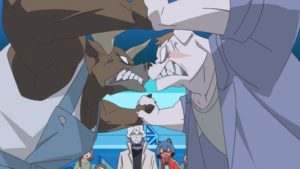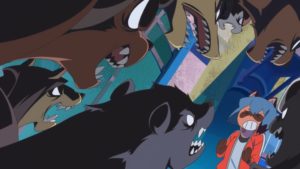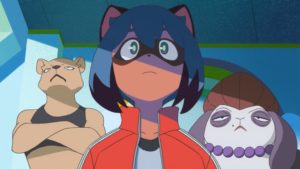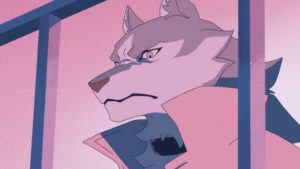Trigger’s latest attempt to Save Anime has arrived, complete with a two-tone color scheme and an unorthodox release schedule. While it was still one of spring’s most anticipated shows (placing second in our season preview poll), the half-cour Netflix rollout and resulting lack of official subs has reduced awareness of the series in broader circles. That didn’t stop me with Dorohedoro, though, and it won’t stop me now. I’m not a big Trigger fan, but my favorite work of theirs was created by Yoh Yoshinari, who’s also directing BNA, so I’ve got a reason to be optimistic here. The show isn’t blowing me away yet – in fact, I have a fair number of criticisms, which we’ll get to in a bit – but since we’re just two episodes in, my patience is still intact. And hey, being so short and so grounded in its own alternate reality, the series probably won’t have time for a groan-worthy trip to space just before the end. Amen to that, eh?
(Note: I’m following Asenshi’s weekly releases, not the batch of six episodes that are already making the rounds online. Don’t expect to see a flurry of BNA posts any time soon.)
So, what is Brand New Animal about? “Everything” is the word that leaps to mind. There are the obvious themes of racism and sexism, political intrigue and hints of pharmaceutical meddling, questions about identity and justice, and the list goes on. Episode 2 is largely concerned with a human trafficking plot (or “beastman trafficking,” I suppose), in which our hero played the unwitting victim. Speaking of that hero, her name is Kagemori Michiru, and it was only in this episode that we were granted that knowledge. I can’t think of many TV shows, anime or otherwise, that kept the main character’s name secret until their second installment, which speaks to BNA’s priorities. This is a series where the big picture is paramount – where the injustice of Michiru’s kidnapping is of more importance than her personal peril. The children she was tutoring are victims of human prejudice (having been orphaned by beastmen hunters en route to Anima City), but their present situation is due to intraspecies strife. After all, Grandma Gran only agreed to sell them to keep the beastman mafia from coming down on her gang.
How viable is the whole beastman trafficking story, apart from its blinking neon sign levels of messaging? My answer would be “not particularly.” Michiru ends up in Rabbit Town after conveniently spotting the pickpocketing primate from episode 1, and is tasked with teaching the aforementioned orphans how to read and write. The show compresses the years-long process of literacy education via cute scene where a kid clumsily writes his own name on a blackboard, then gives the camera a great big smile. The mafia boss’s disdain for women is cartoonish (“you leak all over the place”), and Shirou appearing to save the day overshadows Michiru’s rescue attempt. Most of all, though, this detour has delayed the protagonist’s acclimation to Anima City. I’d like to become acquainted with the setting in all its forms, rather than forcibly viewing it as a series of corrupt back alleys. Meeting Jem and Marissa at the co-op was a start, but come on – this is an anime starring transforming animals! Let me get a sense of how they live day to day.
Let’s talk visuals now. BNA is a Trigger joint, so the show is quite expressive while maintaining an economical animation style. It’s got that in common with Little Witch Academia’s TV version, and I appreciate that aspect of both series. Moments like two alpha males locking horns at City Hall or Michiru extending her arms through the bars of her cage nicely communicate their respective emotions, without requiring too much in-between work. The issue I have with Brand New Animal, however, lies with its backgrounds. Early LWA episodes kept the series’ castle in view at all times, and provided tons of details about its world in the process, but BNA uses solid colors and simple smears too often for my liking. The show is very into its own aesthetic, with the red and blue contrast dominating some scenes to the point of distraction (Shirou’s fight in episode 1 springs to mind). I’m curious whether other people are digging the show’s look, because it’s a mixed bag in my eyes.
Mostly criticism for this episode, then, but I do think BNA is one of the season’s brightest stars. It’s wildly ambitious for a one cour series, and it has a big attitude that may come in handy when selling some of its larger story developments. An opportunity to stop and smell the roses would be appreciated, but my name isn’t Yoh Yoshinari, so I don’t get to pick. Going forward, these posts ought to appear soon after Asenshi’s episodic releases, so even if you’ve already burned through 1-6, you can use this column as a refresher course. BNA promises to be one of spring’s busiest series, after all – I’m looking forward to the rest!





I quite enjoy it so far (though I consider at least one of the first 6 episodes to be weak but let’s ignore that) but I try to not get my hopes up too much. Personal preferences, mainly, but the LWA’s formularic episodical story telling and the one-character focus it had killed it for me so this is what I fear might happen here. So far though, it’s nice. Not nearly as entertaining as the classical Imaishi shows but the MC is cute and she is easy to like, Shiro has potential (or not) depending on what they are planning to do with him and what I do like is that we have an own society here so there are things to explore, and the series is doing this well so far.
I think most of my fears are rooted on the plot related expectations the series might or might not have hinted at as well as the short running time (it’s only 12/3 episodes afaik) that might prevent it from doing anything special, but I love Trigger and don’t want to give up hope so let’s rather wait for the upcoming episodes. There ARE a few things within the first 6 I really liked but I will post about that in the respective threads.
This comment marks the first time I’ve seen Imaishi’s work described as “classical.”